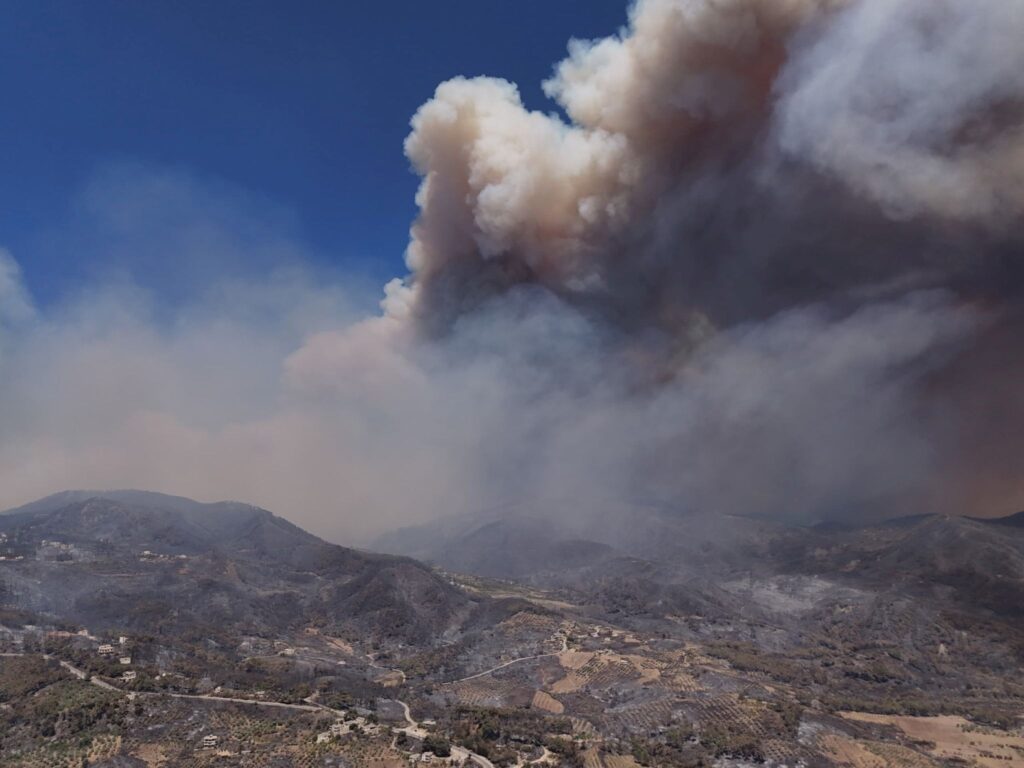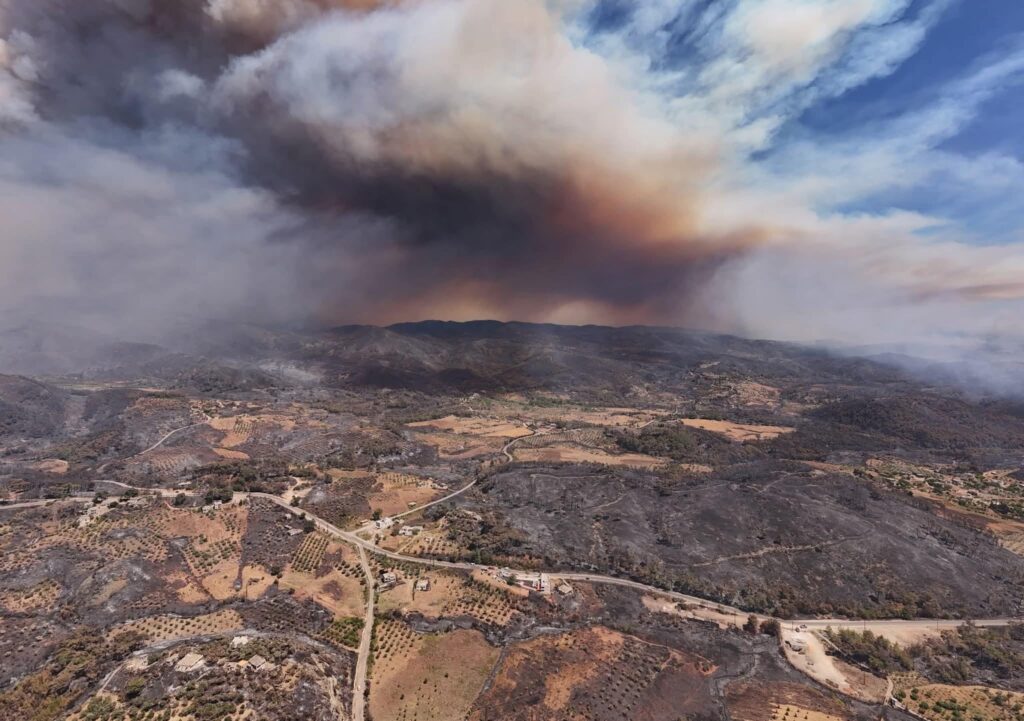Issued by: Guardians of Equality Movement (GEM), for Environmental and Social Justice for the LGBTQIA+ Community in Syria
Date: July 5, 2025
1. Introduction and Context
While both Syria and Turkey are attempting to recover from successive disasters most notably the February 2023 earthquake that left thousands dead, injured, and displaced, and caused massive destruction to infrastructure in both countries the region is now facing a new environmental catastrophe. Since early July, large-scale wildfires have erupted across Syria’s coastal region and parts of western Turkey.
This catastrophe comes at a particularly sensitive time, especially for Syria, which is still struggling to emerge from over a decade of devastating war. The country faces a collapsed economy, widespread destruction of infrastructure, and the deterioration of public services, all of which severely limit its ability to respond to ongoing crises and further deepen the vulnerabilities of affected populations.
In addition, coastal areas in Syria where the wildfires broke out—have experienced waves of military and security escalation since 2025, following the fall of the Assad regime. This has led to bloodshed among civilians and further complicated the humanitarian situation, making emergency response even more fragile.
In Syria, the coastal and northern Latakia countryside has witnessed wildfires that have burned nearly 100 square kilometers (around 10,000 hectares) of forest, according to the United Nations. This accounts for more than 3% of the country’s total forest cover, reducing vast green areas to ash. Fires broke out in areas such as Qastal Maaf, Zunzaf, and Rabia, spreading to surrounding mountainous villages, fueled by an intense heatwave with temperatures exceeding 38°C, alongside strong winds that accelerated the spread and complicated containment efforts.
The wildfires have impacted nearly 5,000 people, displacing more than 1,120 individuals from affected villages including Beit Ayoush, Mazraa, Sboureh, and Basit. At least seven villages were evacuated as a precaution. Fires damaged medium-voltage power lines and knocked the Basit power station offline, resulting in electricity outages and halted water pumping. Farm animals died, shelters were destroyed, and unexploded ordnance and landmines in the burn zones endangered firefighting teams and obstructed access.
The response has been further hindered by outdated equipment, lack of modern communications tools, and the rugged mountainous terrain of the affected areas, making fire suppression efforts significantly more difficult.
In Turkey, similar wildfires broke out in provinces such as Izmir and Hatay, burning more than 50,000 hectares of forests and farmlands. The fires caused the deaths of three people and displaced more than 50,000 rural residents. Extreme heat exceeding 40°C, combined with drought and strong winds, intensified the disaster, prompting a large-scale emergency response.
These wildfires exacerbate pre-existing challenges in both countries—particularly in Syria, where government institutions and civil society actors are struggling to respond with limited resources and severe logistical constraints. Despite determined efforts by civil defense teams and local communities, the scale of the destruction exceeds the capacity of the local response.
This disaster cannot be separated from the broader socio-political context, where its impact intersects with patterns of marginalization and exclusion affecting wide segments of the population including LGBTQIA+ individuals, women, internally displaced persons (IDPs), and residents of remote mountainous areas. Entire communities inhabited by these groups have already been evacuated due to proximity to the fire zones.
According to the United Nations, the region is currently facing the worst climate conditions in 60 years, putting more than 16 million people in Syria and Turkey at risk of worsening food insecurity—at a time when quake-affected communities are still struggling to recover without adequate support.

2. Field Challenges
- Rugged mountainous terrain and absence of firebreaks within forests
- Lack of logistical resources
- Presence of landmines and remnants of war in parts of Syria
- Weak coordination between official entities and local communities
3. Social and Human Rights Impact
- Many LGBTQIA+ individuals live in remote areas or rely on informal support networks, making them especially vulnerable in emergencies where inclusive response mechanisms are lacking.
- Women, particularly single mothers, faced compounded challenges in securing protection for their families due to the absence of safe and inclusive shelter centers.
- Some IDPs who had previously fled to coastal villages following conflict in their original areas were forced to flee once again without guarantees or support.
- The absence of fair and independent media coverage contributed to silencing the voices of affected individuals—especially from underrepresented groups.
4. Environmental Justice as a Pathway to Social Justice
The Guardians of Equality Movement believes that environmental justice is an inseparable part of the struggle for dignity, freedom, and recognition. Natural disasters that occur in contexts of authoritarianism and marginalization are not purely “natural”—they reveal failures in governance and reproduce patterns of exclusion.
5. GEM Recommendations
- Strengthen Local Environmental Governance
Support the establishment of community-based committees in affected areas that include representatives from marginalized groups, to monitor the response and provide direct recommendations to relevant authorities. - Provide Safe and Inclusive Temporary Shelters
Establish emergency shelters that respect privacy and dignity, and ensure protection for LGBTQIA+ individuals, women, and internally displaced persons (IDPs), under the supervision of independent civil society organizations. - Integrate Environmental Justice into Media and Education
Support independent media initiatives that highlight the human rights dimensions of environmental disasters, and promote content that connects environmental issues to citizenship and civic engagement. - Embed Environmental Justice in Recovery and Reconstruction Plans
Ensure that any rehabilitation or reconstruction plans are inclusive and built on frameworks that address the needs of marginalized communities. - Mobilize International Emergency Response
Call for urgent international support to help extinguish the fires, assist affected populations, and contribute to the reforestation of burned areas. - Explicitly Include Marginalized Groups in Emergency Responses
Ensure that LGBTQIA+ communities, IDPs, women, and persons with disabilities are explicitly included in all emergency response mechanisms.
GEM’s Response
The Guardians of Equality Movement has begun responding to this catastrophe by raising awareness about its environmental and humanitarian impacts—particularly on marginalized communities. The organization has started engaging affected individuals and documenting their needs. GEM is also exploring ways to contribute to reforestation and reparations, as part of its deep-rooted commitment to supporting vulnerable communities in times of crisis.
According to GEM’s coastal area coordinator, immediate reforestation of areas recently affected by fires is not currently feasible due to environmental and technical factors. However, there are viable opportunities to reforest areas that burned in previous years, particularly during the 2022 wildfires. Thousands of hectares across Syria remain in need of reforestation, including entire mountain ranges deforested during the war due to reliance on firewood and the lack of legal protections against tree-cutting.
GEM stresses that environmental issues in Syria are now intrinsically tied to national stability and collective security. Early signs of climate displacement are already emerging in parts of northeastern Syria, where towns and villages suffer from drought, water scarcity, and a lack of green spaces and nature reserves.
The Guardians of Equality Movement calls on the international community to take responsibility for this worsening environmental disaster by supporting relief efforts, funding ecological rehabilitation, and standing with communities that now face a dual climate and humanitarian crisis.
Sources:
- Syrian Ministry of Emergency and Disaster Response
- Syrian Civil Defense
- UN Food and Agriculture Organization (FAO)
- GEM Coastal Area Coordinator
- AP News: UN teams deploy to Syrian coast as wildfires force hundreds to flee
- AFP via Arab News: Syria fights ‘catastrophic’ fires for fourth day
- Gulf News: Syria wildfire scorches over 100 km², triggers explosions and exodus
- North Press Agency: Wildfires devastate over 100 km² of forest in Latakia, displacing thousands
- ReliefWeb: SARD Flash Report 01: Latakia Wildfires, Syria (7 July 2025)

